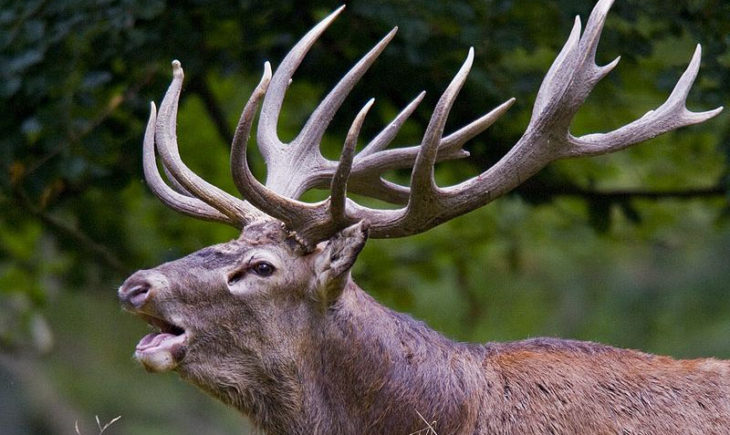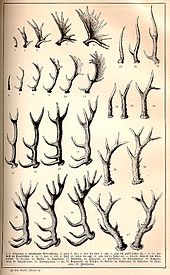Antlers are extensions of an animal’s skull found in members of the deer family. They are true bone and are a single structure. They are generally found only on males, with the exception of the caribou.[1] Antlers are shed and regrown each year and function primarily as objects of sexual attraction and as weapons in fights between males for control of harems.
In contrast, horns, found on pronghorn, sheep, goats, bison, cattle, and many other bovine, are two-part structures. An interior of bone (also an extension of the skull) is covered by an exterior sheath grown by specialized hair follicles, the same material as human fingernails and toenails. Horns are never shed and continue to grow throughout the animal’s life. The exception to this rule is the pronghorn which sheds and regrows its horn sheath each year. They usually grow in symmetrical pairs.
Development
Each antler grows from an attachment point on the skull called a pedicle. While an antler is growing, it is covered with highly vascular skin called velvet, which supplies oxygen and nutrients to the growing bone.[6]Antlers are considered one of the most exaggerated cases of male secondary sexual traits in the animal kingdom,[9] and grow faster than any other mammal bone.[10] Growth occurs at the tip, and is initially cartilage, which is later replaced by bone tissue. Once the antler has achieved its full size, the velvet is lost and the antler’s bone dies. This dead bone structure is the mature antler. In most cases, the bone at the base is destroyed by osteoclasts and the antlers fall off at some point.[6] As a result of their fast growth rate, antlers are considered a handicap since there is an immense nutritional demand on deer to re-grow antlers annually, and thus can be honest signals of metabolic efficiency and food gathering capability.[11]
In most arctic and temperate-zone species, antler growth and shedding is annual, and is controlled by the length of daylight. Although the antlers are regrown each year, their size varies with the age of the animal in many species, increasing annually over several years before reaching maximum size. In tropical species, antlers may be shed at any time of year, and in some species such as the sambar, antlers are shed at different times in the year depending on multiple factors. Some equatorial deer never shed their antlers. Antlers function as weapons in combats between males, which sometimes cause serious wounds, and as dominance and sexual displays.[10]
Carving for decorative and tool uses[edit]
A German powder flaskmade from a red deer antler, c.1570. Wallace Collection, London (2010)
Antler has been used through history as a material to make tools, weapons, ornaments, and toys.[28] It was an especially important material in the European Late Paleolithic, used by the Magdalenian culture to make carvings and engraved designs on objects such as the so-called Bâton de commandements and the Bison Licking Insect Bite. In the Viking Age and medieval period, it formed an important raw material in the craft of comb-making. In later periods, antler – used as a cheap substitute for ivory – was a material especially associated with equipment for hunting, such as saddles and horse harness, guns and daggers, powder flasks, as well as buttons and the like. The decorative display of wall-mounted pairs of antlers has been popular since medieval times at least.[citation needed]
Through history large deer antler from a suitable species (e.g. red deer) were often cut down to its shaft and its lowest tine and used as a one-pointed pickax.[29][30]
Ceremonial roles
Antler headdresses were worn by shamans and other spiritual figures in various cultures, and for dances; 21 antler “frontlets” apparently for wearing on the head, and over 10,000 years old, have been excavated at the English Mesolithic site of Starr Carr. Antlers are still worn in traditional dances such as Yaqui deer dances and carried in the Abbots Bromley Horn Dance.[citation needed]
Dietary usage
In the velvet antler stage, antlers of elk and deer have been used in Asia as a dietary supplement or alternative medicinal substance for more than 2,000 years.[31] Recently, deer antler extract has become popular among Western athletes and body builders because the extract, with its trace amounts of IGF-1, is believed to help build and repair muscle tissue, however, one double-blind study did not find evidence of intended effects.[32][33]
Elk, deer, and moose antlers have also become popular forms of dog chews that owners purchase for their pet canines.[34]
|
Ckalari is my friend |
z35W7z4v9z8w






